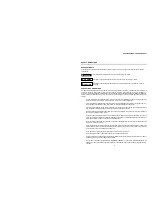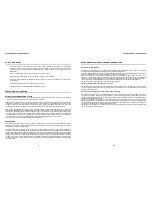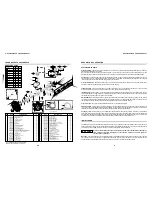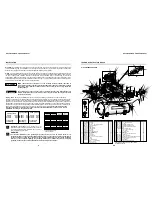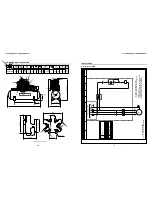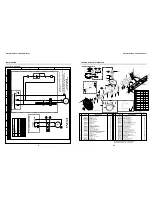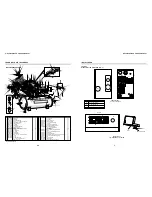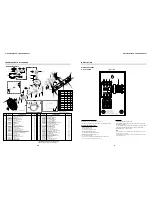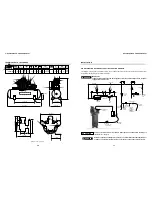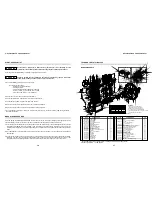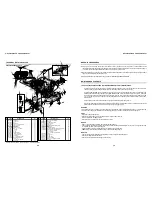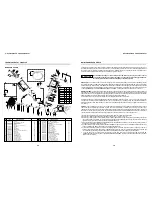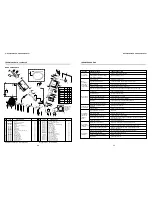
DESCRIPTION OF OPERATION
PRINCIPLES OF COMPRESSION CYCLES
A reciprocating compressor is a piston type pump that develops pressure from the action of a piston moving through a
cylinder. The cylinder, or cylinders, may be vertical, horizontal, or angular.
- When air is drawn in from the atmosphere and compressed to its final pressure in a single stroke, the
compressor is referred to as a
“
single stage
”
pump. During the downstroke of a single stage compressor, air is drawn
through an intake valve in the head of the compressor and into the cylinder. At the bottom of the stroke, the intake valve
closes and air is trapped in the cylinder. The air is then compressed in the cylinder during the upstroke of the piston.
- Compressing air to higher pressure it is accomplished by using multiple stages. During the downstroke of
the piston of a
pump, air is drawn through an intake valve in the head of the compressor, into the low-pressure
cylinder and compressed during the upstroke of the piston. The compressed air is then released through a discharge valve
in the head of the compressor to an intercooler where the heat resulting from compression is allowed to dissipate. The
cooler compressed air is then drawn into a second compression cylinder, the high pressure cylinder, for compression to
final pressure. From there the compressed air is released through a discharge valve to an air receiver tank.
In one revolution of the crankshaft a compression cycle is completed.
SINGLE STAGE
TWO STAGE
“
two stage
”
APPLICATIONS
Single estage compressors normally runs in the 95 up to 125 psi range. These pressure settings are designed to provide
working air in the 90 up to 100 psi range that most air tools operate. These compressors are generally used in lighter duty
applications such as in your garage at home.
A two-stage compressor normally run in the 145 up to 175 psi range. The higher-pressure setting of the two-stage unit is
required in commercial and industrial applications that have tools and equipment such as in-ground lifts and tire changers
that need air at higher pressure than a single stage compressor can provide. Two stage compressors are generally better
suited for commercial use for several other important reasons. First, this high-pressure air is store in the tank as
“
available
energy
”
so the compressor runs less. Secondly, two stage compressors run at much lower discharge temperatures so that
you have cooler, dryer air in the shop air system. The two-stage compressor is more versatile because it gives the shop
owner the ability to use the higher pressures when necessary but also use air regulated down of the 90 up to 100 psi range
for normal air tools.
AIR COMPRESSOR - OWNER'S MANUAL
SAFETY GUIDELINES
- Provisions should be made to have the owners manual readily available to the operator and maintenance
personnel. If for any reason any part of the manual becomes illegible or the manual is lost, have it replaced
immediately. The owners manual should be read periodically to refresh one
’
s memory. It may prevent a serious or
fatal accident.
- Never use a flammable or toxic solvent for cleaning the air filter or any parts.
- Make a general overall inspection of the unit daily and correct any unsafe conditions.
- Never play with compressed air. Reckless behavior of any kind involving compressed air can cause serious
personal injury.
- Periodically check all pressure relief valves for proper operation.
- Any alterations to the compressor must have prior factory approval.
2
ENVIRONMENTAL GUIDANCE AND RECOMMENDATIONS
1. Disposal of Liquid Effluents
2. Draining the Lubricant Oil from the Compressor Unit
3. Disposal of Solid Waste (parts in general and product packages)
The presence of liquid effluents or non-treated condensation from tank and separator in rivers, lakes or in other water
receiving bodies may adversely affect the aquatic life and the water quality as well.
The condensation withdrawn from the tank and separator, daily, according to the Preventive Maintenance Chapter, must
be kept in a container and/or in an appropriate collecting network for further treatment.
Schulz, the manufacturer of the product, recommends that the liquid effluent produced inside the receiver of the
compressor or condensed separator
should be adequately treated through processes that aim at protecting the
environment and the healthy quality of life of the population, complying with the country's current regulation requirements.
Among the treatment methods available, one may choose the physical-chemical, chemical, and biological ones.
The treatment may be carried out by the company itself or by outsourcing.
The disposal of the lubricant oil coming from the lubricant oil change located in the crankcase of the piston compressor
must meet technical requirements, as well as the regulation requirements of the current legislation of the country the
product has been exported to.
The generation of solid waste is an important aspect that must be considered by the users when using and maintaining
their piece of equipment. The impacts to the environment may cause meaningful changes in the quality of the soil, in
surface and underground water, and in the population's health, due to the inadequate disposal of the discarded residues
(on streets, water springs, landfills, etc).
Schulz, the manufacturer of the product, recommends that the waste arising from the product, from its generation,
handling, transportation, and treatment to its final disposal should the handled carefully. Appropriate handling should
consider the following steps: quantification, qualification, classification, reduction at source, pick-ups and selective pick-
ups, recycling, storage, transport, treatment and final destination.
The disposal of solid waste must be carried out according to the regulation requirements of the current legislation of the
country the product has been exported to.
47
AIR COMPRESSOR - OWNER'S MANUAL



